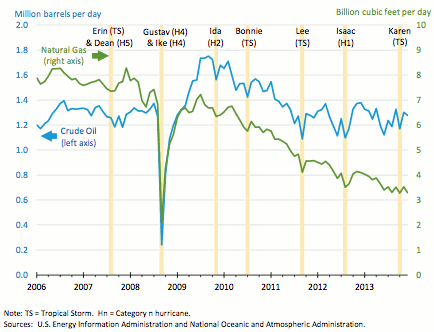The U.S. Energy Information Administration has published an estimate for hurricane and tropical storm-related oil & natural gas production disruption for the Gulf of Mexico, based on the latest NOAA 2014 Atlantic hurricane season forecast.
The EIA estimates that, based on the NOAA hurricane season forecast of 8 to 13 named storms, 3 to 6 hurricanes and 1 to 2 major hurricanes, as much as 11.6 million barrels of crude oil and 29.7 billion cubic feet of natural gas production could be disrupted by the 2014 hurricane season.
The analysis from the EIA results in a 69% probability that production shut-in volumes will be equal to or greater than the production shut in during the 2013 hurricane season. The 2013 season saw 3.1 million barrels of crude oil and 6.7 billion cubic feet of natural gas production shut down due to storms.
The EIA notes that the actual volume of production that gets shut-in during the 2014 hurricane season could differ dramatically from their estimates, depending on the number, intensity and track of storms that form. However its estimate provides a rough guide for the impact to U.S. oil and gas production from the hurricane season and so are a useful warning for energy insurance and reinsurance firms with exposure to Gulf of Mexico shut-ins.
The EIA provides a useful chart showing how recent storms have affected production of Gulf of Mexico oil and natural gas. Two interesting points on this chart, the impact of a major hurricane such as Ike or Gustav is clear with the majority of production shut down across the Gulf and secondly the decline in Gulf gas production in recent years.

The impact of hurricanes and tropical storms from 2006-2013 on crude oil and natural gas production in the federal offshore Gulf of Mexico - Source: U.S. EIA
The EIA notes that the effect on U.S. supply of a major hurricane would now be lower than in previous years, due to the declining production in the Gulf of Mexico. However this won’t change the potential impact to insurers and reinsurers, particularly with the removal and decommissioning of rigs also being insured.
The reinsurance and insurance-linked securities (ILS) market has in recent years been placing an increasing focus on gaining access to underwriting energy risks, particularly physical damage risks due to storms and earthquakes. We have even seen Gulf of Mexico production assets included in a catastrophe bond, AIG’s Tradewynd Re deal.
There has been a reported increase in interest in providing Gulf of Mexico focused parametric coverage, using cat-in-a-box type structures, in the last year as well, which again has had some support from alternative reinsurance capital and ILS specialists, it is understood.
With an increasing amount of ILS capital at risk in the Gulf of Mexico, as well as on the shore through catastrophe bonds and collateralized reinsurance, the exposure to hurricane impacts on the oil and gas production network in and around the Gulf is growing.
Don’t forget to bookmark our 2014 Atlantic hurricane season page to keep up to date on any storms as they develop.
You can download a full copy of the EIA’s 2014 outlook for Gulf of Mexico hurricane-related production outages.
 View all of our Artemis Live video interviews and subscribe to our podcast.
View all of our Artemis Live video interviews and subscribe to our podcast.
All of our Artemis Live insurance-linked securities (ILS), catastrophe bonds and reinsurance video content and video interviews can be accessed online.
Our Artemis Live podcast can be subscribed to using the typical podcast services providers, including Apple, Google, Spotify and more.































